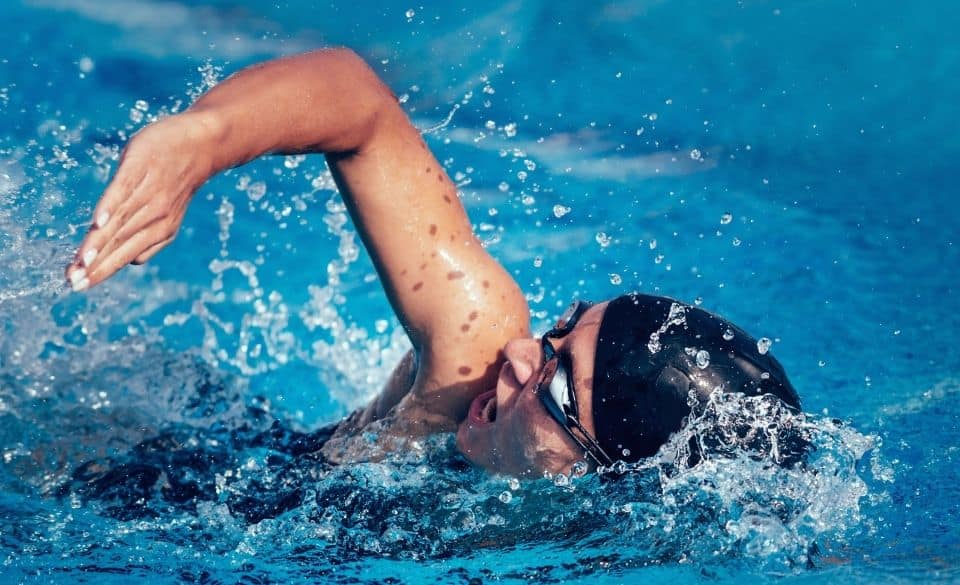
Swimmers Elbow – A Complete Guide To Swimmers Elbow & Treatment
Page Contents
Swimmers elbow is an injury many triathletes develop when increasing their training load too fast. However, beginners are more commonly affected because of their poor technique. Affected areas include pain around the outside of the elbow and inside of the elbow.
So what can you do to prevent, treat and recover from swimmers elbow?
Swimmers Elbow – A Complete Guide
Many triathletes and swimmers suffer from pain or discomfort around the elbow. This is largely due to the force of the arm pull during crawl and other strokes. For many beginners, it can often be caused by bad technique or overuse.
Because both swimmers and triathletes use their elbows in a form of ‘elbow-up pull’ which requires the swimmer to bend and hold the elbow at a certain angle during different types of strokes. They can often find themselves dealing with stiff and painful areas around the elbow.
Swimmers elbow is a general name for epicondylitis and is usually caused by the following:
– A sudden increase in volume or distance
– Overuse of paddles
– A lack of gradual build-up
– Starting back training too quickly after a lay-off
– Technique issues
The above causes can cause lateral or medial epicondylitis if not treated early. But what is the difference between these elbow injuries?
Medial epicondylitis – commonly known as golfers elbow. It is a type of tendonitis that causes pain and/or inflammation inside the elbow. This often starts affecting the swimmer when the tendons of the forearm muscle that connects to the bone become swollen or painful.
Lateral epicondylitis – Similar to medial epicondylitis is a condition caused by overload. This is common within sports that incur repetitive motions of the arm such as swimming and tennis.
As a triathlete, your swimming fitness may be high and your technique may be good, that doesn’t mean swimmers elbow won’t affect you at some point.
For more experienced swimmers it usually comes on after years of repetitive shoulder and elbow movements. While inexperienced swimmers are often affected much quicker because of bad technique.
Whether your training for a sprint distance, Olympic distance, or Ironman triathlon. It is important if you experience any pain around the elbow to apply RICE (Rest, Ice, Compression, Elevation) until the symptoms subside.
![]()
Medial Epicondylitis In Swimming
As a triathlete, we often experience overuse injuries in running more than swimming or cycling. However, that doesn’t mean we are safe from overuse injuries in swimming.
Elbow pain, specifically Medial Epicondylitis in swimming is very common within the triathlon community. The medial epicondyle (bump you feel over the inside of the elbow) is largely responsible for movements of the wrist and fingers and a host of other muscular elements. When these areas are overloaded repeatedly it places undue stress on the elbow.
Medial epicondylitis in swimming happens when an activity overloads the wrist and elbow repetitively. Hand entry is the last part of a long musculoskeletal chain during the swim stroke. If one of these movements in the chain doesn’t follow the correct path, it will place undue stress down the chain. Commonly around the shoulders and elbows.
Swimmers that struggle with shoulder stiffness may find they subconsciously alter their stroke, which is a common cause of Medial Epicondylitis in swimming.
Knowing this, sometimes subtle changes in your stroke and technique can also cause Medial Epicondylitis. So it is important if you experience any of the symptoms below, rest and focus on kicking and other swimming drills until the symptoms have passed.
– Elbow Pain that follows the forearm (inside) to the wrist.
– Pain and discomfort when flexing your wrist
– Pain and discomfort when shaking your hands
– Numbness and/or tingling from the elbow to the fingers
Medial epicondylitis caused by swimming can be cured by resting and using a non-steroidal anti-inflammatory. During this time any arm movement can be replaced with kicking or other drills that don’t involve movement of the elbow.
Once the pain has passed you can start looking at a strengthening program. During this time it is also wise to consider changing your training or current swim technique. This will help to prevent its recurrence.
Swimming With Elbow Pain – What You Should Know?
Although swimming is considered an excellent form of aerobic training, it does place undue stress on the muscles and joints involved. While it is not as much stress as running and other sports, the repetitive motion of swimming can cause injuries if not enough rest or stretching is applied.
Since triathletes often swim high mileage in the pool, it is not uncommon to see triathletes swimming with elbow pain thinking it may disappear over time.
If you experience any form of elbow pain while swimming. Take some time to look at your training plan and technique to find the cause of the problem. Continuing to swim with swimmers elbow may develop into more serious issues as we talked about (Medial or Lateral epicondylitis).
If you are new to swimming you should spend some time with a qualified swim coach to overlook your technique to make sure this isn’t a large cause of the problem. If you are a more experienced triathlete look to hire a triathlon coach that can overlook your training plan to prevent any overuse issues from happening.

Front Crawl Elbow Pain
Elbow pain when swimming front crawl can often be caused by locking out the elbow during the last phase of the stroke. Other factors such as hyperextension, tight shoulders, and overuse are other causes of front crawl elbow pain.
While swimming front crawl doesn’t affect the elbows as much as breaststroke or butterfly, it is still a common injury triathletes face.
Whether you are experiencing elbow pain or just fatigue, it is important to follow the recovery tips below. This will help you get back into the pool as quickly as possible.
Swimming Elbow Treatment
Treatment of elbow injuries from swimming requires often rest for a period of time. Depending on how bad the symptoms are you may be able to continue swimming at a lower intensity. The most common ways to treat symptoms are by:
– Complete rest
– RICE (Rest, Ice, Compression, Elevation)
– Anti-inflammatories
If you have less severe pain in the elbow you can continue to swim at a lower intensity. It is recommended if the pain doesn’t worsen to look at your technique to make sure this isn’t the cause of the problem.
However, it is often hard to find the cause of the problem, so it is recommended to see a physio or sports doctor before continuing to swim.



